Untitled
Earthquake engineering is the study of the behavior of buildings and structures subject to seismic loading. It is a subset of both structural and civil engineering. Eminent authority on seismic risk mitigation, Caltech professor George W. Housner is widely considered as the 'father' of the modern field of earthquake engineering. Stanford University professor John Blume’s contributions to the dynamics of structures have earned him the title of the 'father' of earthquake engineering too.
The main objectives of earthquake engineering are:
- Understand the interaction between buildings or civil infrastructure and the ground.
- Foresee the potential consequences of strong earthquakes on urban areas and civil infrastructure.
- Design, construct and maintain structures to perform at earthquake exposure up to the expectations and in compliance with building codes[1].
A properly engineered structure does not necessarily have to be extremely strong or expensive.


The most powerful and budgetary tools of earthquake engineering are vibration control technologies and, in particular, base isolation.
Seismic loading

Seismic loading means application of an earthquake-generated agitation to a structure. It happens at contact surfaces of a structure either with the ground [6], or with adjacent structures [7], or with gravity waves from tsunami. Seismic loading depends, primarily, on:
- Anticipated earthquake's parameters at the site
- Geotechnical parameters of the site
- Structure's parameters
- Characteristics of the anticipated gravity waves from tsunami (if applicable).
Sometimes, seismic load exceeds ability of a structure to resist it without being broken, partially or completely. Due to their mutual interaction, seismic loading and seismic performance of a structure are intimately related.
Seismic performance

Basic concepts of the earthquake engineering, implemented in the major building codes, assume that a building should survive The Big One (the most powerful anticipated earthquake) though with partial destruction. Drawing an analogy with a human body, it will have dislocated joints, fractured ribs, traumatized spine and knocked out teeth but be alive and, therefore, acceptable according to the prescriptive building codes [8]. This situation is a major barrier to implementation of any structural innovations in the earthquake engineering technologies employing vibration control and, particularly, the most effective brands of base isolation. However, alternative earthquake performance-based design approaches already exist. Some of them, for assessment or comparison of the anticipated earthquake performance, use the Story Performance Rating R as a major criterion [9] while the Seismic Performance Ratio (SPR) is used for a rather accurate prediction of earthquake performance of a building up to the point of its state of "severe damage" [10].
Seismic performance evaluation
Performance evaluation of building structures at their earthquake exposure is one of the hottest topics of earthquake engineering [11]. Engineers need to know the quantified level of an actual or anticipated seismic performance associated with the direct damage to an individual building subject to a specified ground shaking. The best way to do it is to put the structure on a shake-table that simulates the earth shaking and watch what may happen next (if you have no time to stand out in the field and wait for a real earthquake to strike, of course). Such kinds of experiments were performed still more than a century ago

- Ground Acceleration Mitigation Factor, when only some maximum accelerations on a structure are available [14], and
- Story Performance Rating, when the story drifts are also known [15].

Seismic performance analysis
Seismic performance analysis or, simply, seismic analysis is a major intellectual tool of earthquake engineering which breaks the complex topic into smaller parts to gain a better understanding of seismic performance of building and non-building structures. The technique as a formal concept is a relatively recent development.However, those spectra are good, mostly, for single-degree-of-freedom systems. Numerical step-by-step integration[5], applied with the charts of seismic performance [19], proved to be a more effective method of analysis for multi-degree-of-freedom structural systems with severe non-linearity under a substantially transient process of kinematic excitation.
Research for earthquake engineering
Research programs
The NSF programs support research on new technologies for improving the behavior and response of structural systems subject to earthquake hazards; fundamental research on safety and reliability of constructed systems; innovative developments in analysis and model based simulation of structural behavior and response including soil-structure interaction; design concepts that improve structure performance and flexibility; and application of new control techniques for structural systems [20].
NSF also supports George E. Brown, Jr. Network for Earthquake Engineering Simulation (NEES) [21] that advances knowledge discovery and innovation for earthquake and tsunami loss reduction of the nation's civil infrastructure, and new experimental simulation techniques and instrumentation.
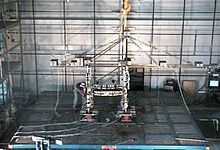
Earthquake simulation
The very first earthquake simulations were performed by statically applying some horizontal inertia forces based on scaled peak ground accelerations to a mathematical model of a building [6]. With the further development of computational technologies, static approaches began to give way to dynamic ones.

[25].
Structure simulation
Theoretical or experimental evaluation of anticipated seismic performance mostly requires a structure simulation which is based on the concept of structural likeness or similarity. Similarity is some degree of analogy or resemblance between two or more objects. The notion of similarity rests either on exact or approximate repetitions of patterns in the compared items.

In general, a building model is said to have similarity with the real object if the two share geometric similarity, kinematic similarity and dynamic similarity. The most vivid and effective type of similarity is the kinematic one. Kinematic similarity is the similarity of time as well as geometry. It exists between a model and prototype when:
- the paths of moving particles are geometrically similar;
- the ratios of the velocities of particles are similar.
The ultimate level of kinematic similarity is kinematic equivalence when, in the case of earthquake engineering, time-histories of each story lateral displacements of the model and its prototype would be the same [26].
Seismic vibration control
Seismic vibration control is a set of technical means aimed to mitigate seismic impacts in building and non-building structures [27]. All seismic vibration control devices may be classified as passive, active or hybrid [28] where:
- passive control devices have no feedback capability between them, structural elements and the ground;
- active control devices are force delivery devices integrated with real-time processing sensors and evaluators/controllers within the structure and on the ground;
- hybrid control devices have combined features of active and passive control systems.[7]

- to dissipate the wave energy inside a superstructure with properly engineered dampers;
- to disperse the wave energy between a wider range of frequencies by adequately configuring a building elevation [29], [30];
- to reflect, diffract, and dissipate seismic waves in a process of their vertical propagation with the help of elevated building foundation (EBF) [31];
- to absorb the resonant portions of the whole wave frequencies band with the help of so called mass dampers [32].
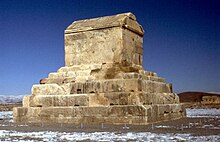
The first evidence of earthquake protection by using the principle of base isolation was discovered in Pasargadae, a city in ancient Persia, now Iran: it goes back to VI century BC. Below, there are some samples of seismic vibration control technologies of today.
Earthquake protector
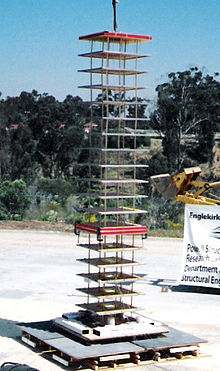
Heavy damping mechanism sometimes incorporated in vibration control technologies and, particularly, in base isolation devices may be considered a valuable source of suppressing vibrations thus enhancing a building's seismic performance. However, for the very pliant systems such as base isolated structures, with a relatively low bearing stiffness but with a high damping, the so-called "damping force" may turn out the main pushing force at a strong earthquake[35]. This finding created a theoretical ground for the new damping-disengaged base isolation technology called Earthquake Protector [36].
Tuned mass damper
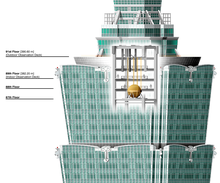
Typically, the tuned mass dampers are huge concrete blocks mounted in skyscrapers or other structures and moved in opposition to the resonance frequency oscillations of the structures by means of some sort of spring mechanism.
Taipei 101 skyscraper needs to withstand typhoon winds and earthquake tremors common in its area of the Asia-Pacific. For this purpose, a steel pendulum weighing 660 metric tons that serves as a tuned mass damper was designed and installed atop the structure. Suspended from the 92nd to the 88th floor, the pendulum sways to decrease resonant amplifications of lateral displacements in the building caused by earthquakes and strong gusts.
Friction pendulum bearing
Friction Pendulum Bearing (FPB) is another name of Friction Pendulum System (FPS). It is based on three pillars[8]:
- articulated friction slider;
- spherical concave sliding surface;
- enclosing cylinder for lateral displacement restraint.
Snapshot with the link to video clip of a shake-table testing of FPB system supporting a rigid building model is presented at the right.
Elevated building foundation

[37].
Seismic design
Seismic design is based on authorized engineering procedures, principles and criteria meant to design or retrofit structures subject to earthquake exposure[6]. Those criteria are consistent just with the contemporary state of the knowledge about earthquakes and structures[9]. Therefore, the building design which blindly follows some seismic code regulations does not guarantee safety against collapse or serious damage [38].
The price of poor seismic design may be enormous. Nevertheless, seismic design has always been a trial and error process no matter it was based upon physical laws or empirical knowledge of the structural performance of different shapes and materials.

To practice seismic design, seismic analysis or seismic evaluation of new and existing civil engineering projects, an engineer should, normally, pass examination on Seismic Principles [39] which, e.g. in the State of California, include:
- Seismic Data and Seismic Design Criteria
- Seismic Characteristics of Engineered Systems
- Seismic Forces
- Seismic Analysis Procedures
- Seismic Detailing and Construction Quality Control

To build up complex structural systems[10], seismic design utilizes, mostly, the same relatively small number of basic structural elements (to say nothing of vibration control devices) as any non-seismic design project.
Normally, according to building codes, structures are designed to "withstand" the largest earthquake of a certain probability that is likely to occur at their location. This means the loss of life should be minimized by preventing collapse of the buildings.
Seismic design is carried out by understanding the possible failure modes of a structure and providing the structure with appropriate strength, stiffness and configuration[11] to ensure those modes cannot occur.
Seismic design requirements
Seismic design requirements depend on the type of the structure, locality of the project and its authorities which stipulate applicable seismic design codes and criteria [12]. For instance, California Department of Transportation's requirements called The Seismic Design Criteria (SDC) and aimed at the design of new bridges in California [40] incorporate an innovative seismic performance based approach.The most significant feature in the SDC design philosophy is a shift from a force-based assessment of seismic demand to a displacement-based assessment of demand and capacity. Thus, the newly adopted displacement approach is based on comparing the elastic displacement demand to the inelastic displacement capacity of the primary structural components while insuring a minimum level of inelastic capacity at all potential plastic hinge locations.In addition to the designed structure itself, seismic design requirements may include a ground stabilization underneath the structure: sometimes, heavily shaken ground breaks up which leads to collapse of the structure sitting upon it [41].The following topics should be of primary concerns: liquefaction; dynamic lateral earth pressures on retaining walls; seismic slope stability; earthquake-induced settlement [13].
Failure modes
Failure mode is the manner by which a failure is observed. It, generally, describes the way the failure occurs. Though costly and time consuming, learning from each real earthquake failure remains a routine recipe for advancement in seismic design methods. Below, some typical modes of earthquake-generated failures are presented.
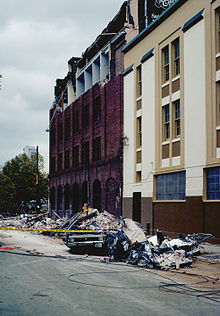
The lack of reinforcement coupled with poor mortar and inadequate roof-to-wall ties can result in substantial damage to a unreinforced masonry building. Severely cracked or leaning walls are some of the most common earthquake damage. Also hazardous is the damage that may occur between the walls and roof or floor diaphragms. Separation between the framing and the walls can jeopardize the vertical support of roof and floor systems.

Soft story effect. Absence of adequate shear walls on the garage level exacerbated damage to this structure. A close examination of the image reveals that the rough board siding, once covered by a brick veneer, has been completely dismantled from the studwall. Only the rigidity of the floor above combined with the support on the two hidden sides by continuous walls, not penetrated with large doors as on the street sides, is preventing full collapse of the structure.
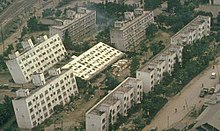
Soil liquefaction. In cases where the soil consists of loose granular deposited materials with the tendency to develop excessive hydrostatic pore water pressure of sufficient magnitude and compact, liquefaction of those loose saturated deposits may result in non-uniform settlements and tilting of structures. This caused major damage to thousands of buildings in Niigata, Japan in 1964 [42].
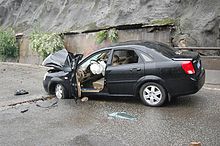
Landslide rock fall. A landslide is a geological phenomenon which includes a wide range of ground movement, including rock falls. Typically, the action of gravity is the primary driving force for a landslide to occur though in this case there was another contributing factor which affected the original slope stability: the landslide required an earthquake trigger before being released.
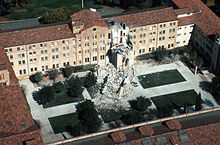
Pounding against adjacent building. This is a photograph of the collapsed five-story tower, St. Joseph's Seminary, Los Altos, California. One person working in the tower was killed. During Loma Prieta earthquake, the tower pounded against the independently vibrating adjacent building behind. A possibility of pounding depends on both buildings' lateral displacements which should be accurately estimated and accounted for.
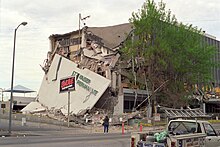
At Northridge earthquake, the Kaiser Permanente concrete frame office building had joints completely shattered, revealing inadequate confinement steel, which resulted in the second story collapse. In the transverse direction, composite end shear walls, consisting of two wythes of brick and a layer of shotcrete that carried the lateral load, peeled apart because of inadequate through-ties and failed.
- Improper construction site
- Poor detailing of the reinforcement ( lack of concrete confinement in the columns and at the beam-column joints, inadequate splice length)
- Weak/soft story (open space at the first floors)
- Long cantilevers with heavy load

If a superstructure is not mounted on a base isolation system, its shifting on the basement should be prevented.

Reinforced concrete column burst at Northridge earthquake due to consisting of two wythes of brickinsufficient shear reinforcement mode which allows main reinforcement to buckle outwards. The deck unseated at the hinge and failed in shear. As a result, the La Cienega-Venice underpass section of the 10 Freeway collapsed.

Loma Prieta earthquake: side view of reinforced concrete support-columns failure and the upper deck collapse onto the lower deck of two-level Cypress viaduct of Interstate Highway 880, Oakland, CA.

Retaining wall failure at Loma Prieta earthquake in Santa Cruz Mountains area: prominent northwest-trending extensional cracks up to 12 cm (4.7 in) wide in the concrete spillway to Austrian Dam, the north abutment.

consisting of two wythes of brickGround shaking triggered liquefaction in a subsurface layer of sand, producing differential lateral and vertical movement in a overlying carapace of unliquified sand and silt. This mode of ground failure, termed lateral spreading, is a principal cause of liquefaction-related earthquake damage [43].
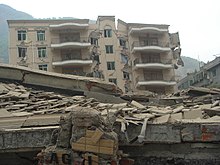
Severely damaged building of Agriculture Development Bank of China after 2008 Sichuan earthquake: most of the beams and pier columns are sheared. Large diagonal cracks in masonry and veneer are due to in-plane loads while abrupt settlement of the right end of the building should be attributed to a landfill which may be hazardous even without any earthquake, see video footage at [44].

2004 Indian Ocean earthquake of December 26, 2004, with the epicenter off the west coast of Sumatra, Indonesia, triggered a series of devastating tsunamis, killing more than 225,000 people in eleven countries by inundating surrounding coastal communities with huge waves up to 30 meters (100 feet) high. For a video footage of the tsunami propagation, click on [45].
Earthquake construction
Earthquake construction means implementation of seismic design to enable building and non-building structures to live through the anticipated earthquake exposure up to the expectations and in compliance with the applicable building codes.
Design and construction are intimately related. To achieve a good workmanship, detailing of the members and their connections should be, possibly, simple. As any construction in general, earthquake construction is a process that consists of the building, retrofitting or assembling of infrastructure given the materials available [14].
The destabilizing action of an earthquake on constructions may be direct (seismic motion of the ground) or indirect (earthquake-induced landslides, soil liquefaction and waves of tsunami).
A structure might have all the appearances of stability, yet offer nothing but danger when an earthquake occurs [46]. The crucial fact is that, for safety, earthquake-resistant construction techniques are as important as quality control and using correct materials. Earthquake contractor should be registered in the state of the project location, bonded and insured.
To minimize possible losses, construction process should be organized with keeping in mind that earthquake may strike any time prior to the end of construction.
Each construction project requires a qualified team of professionals who understand the basic features of seismic performance of different structures as well as construction management.
Adobe structures

One half of the world's population [47] lives or works in the buildings made of earth. Adobe type of mud bricks is one of the oldest and most widely used building materials. The use of adobe is very common in some of the world's most hazard-prone regions, traditionally across Latin America, Africa, Indian subcontinent and other parts of Asia, Middle East and Southern Europe.
Adobe buildings are considered very vulnerable at strong quakes [48]. However, multiple ways of seismic strengthening of new and existing adobe buildings are available, see, e.g., [49].
Key factors for the improved seismic performance ofadobe construction are:
- Quality of construction.
- Compact, box-type layout.
- Seismic reinforcement [50].
Limestone and sandstone structures
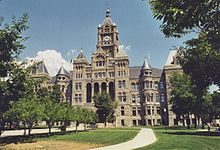
Limestone is very common in architecture, especially in North America and Europe. Many landmarks across the world, including the pyramids in Egypt, are made of limestone. Many medieval churches and castles in Europe are made of limestone and sandstone masonry. They are the long-lasting materials but their rather heavy weight is not beneficial for adequate seismic performance [51].
Application of modern technology to seismic retrofitting can enhance the survivability of unreinforced masonry structures. As an example, from 1973 to 1989, the City and County Building, Salt Lake City, Utah was exhaustively renovated and repaired with an emphasis on preserving historical accuracy in appearance. This was done in concert with a seismic upgrade that placed the weak sandstone structure on base isolation foundation to better protect it from earthquake damage.
Timber frame structures

Timber framing dates back thousands of years, and has been used in many parts of the world during various periods such as ancient Japan, Europe and medieval England in localities where timber was in good supply and building stone and the skills to work it were not.
The use of timber framing in buildings provides their complete skeletal framing which offers some structural benefits as the timber frame, if properly engineered, lends itself to better seismic survivability [15].
Light-frame structures
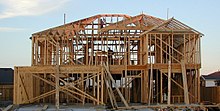
Light-frame structures usually gain seismic resistance from rigid plywood shear walls and wood structural panel diaphragms [52]. Special provisions for seismic load-resisting systems for all engineered wood structures requires consideration of diaphragm ratios, horizontal and vertical diaphragm shears, and connector/fastener values. In addition, collectors or drag struts to distribute shear along a diaphragm length are required.
Reinforced masonry structures

A construction system where steel reinforcement is embedded in the mortar joints of masonry or placed in holes and after filled with concrete or grout is called reinforced masonry [53].
Devastating 1933 Long Beach earthquake revealed that masonry construction should be improved immediately. Then, the California State Code made the reinforced masonry mandatory.
There are various practices and techniques to achieve reinforced masonry. The most common type is the reinforced hollow unit masonry. The effectiveness of both vertical and horizontal reinforcement strongly depends on the type and quality of the masonry, i.e. masonry units and mortar.
To achieve a ductile behavior of masonry, it is necessary that the shear strength of the wall is greater than the tensile strength of reinforcement to ensure a kind of bending failure [16].
Reinforced concrete structures

To prevent catastropic collapse in response earth shaking (in the interest of life safety), a traditional reinforced concrete frame should have ductile joints. Depending upon the methods used and the imposed seismic forces, such buildings may be immediately usable, require extensive repair, or may have to be demolished. [54].
Prestressed structures
Prestressed structure is the one whose overall integrity, stability and security depend, primarily, on a prestressing. Prestressing means the intentional creation of permanent stresses in a structure for the purpose of improving its performance under various service conditions[17].

There are the following basic types of prestressing:
- Pre-compression (mostly, with the own weight of a structure)
- Pretensioning with high-strength embedded tendons
- Post-tensioning with high-strength bonded or unbonded tendons

Steel structures
Steel structures are considered, mostly, earthquake resistant but their resistance should never be taken for granted [57].
Thus, a great number of welded steel moment frame buildings, which looked earthquake-proof, surprisingly experienced brittle behavior and were hazardously damaged in the 1994 Northridge earthquake. After that, FEMA initiated development of repair techniques and new design approaches to minimize damage to steel moment frame buildings in future earthquakes [58].
For structural steel seismic design based on Load and Resistance Factor Design (LRFD) approach, it is very important to assess ability of a structure to develop and maintain its bearing resistance in the inelastic range. A measure of this ability is ductility, which may be observed in a material itself, in a structural element, or to a whole structure.
As a consequence of Northridge earthquake experience, all pre-qualified connection details and design methods contained in the building codes of that time have been rescinded. The new provisions stipulated that new designs be substantiated by testing (see, e.g., [59]) or by use of test-verified calculations.
Prediction of earthquake losses
Earthquake loss estimation is usually performed in terms of a Damage Ratio (DR) which is a ratio of the earthquake damage dollar amount to total value of a building[20]. For a long time, it was associated with a collection of mass inventory data and was based, mostly, on experts' opinions. It looked, therefore, more like an art than a science.

ShakeZone for kids

Some valuable information on earthquakes and earthquake engineering for kids and not just them may be found at the FEMA web-site at [61]. It offers:
- Earthquake fact or fiction
- Home hazard hunt
- Historic earthquakes
- Tasty quake
- Map of earthquake-risk states
- Earthquake disaster math
- Disaster intensity scales
- Water, wind, and earth game, and
- Earthquake legends
It includes, also, some safety things to know and how to protect your pets and home from disasters.More advanced information including shake-table videos of real testing events is presented at theCSUN's ShakeZone for kids portal at [62]. Funny videos of earthquake simulation may be found at [63] and an impressive footage of tsunami at [64].
See also
References
External links
- EERI website
- Earthquake Engineering Research Center
- John A. Blume Earthquake Engineering Center
- Consortium of Universities for Research in Earthquake Engineering (CUREE)
- Multidisciplinary Center for Earthquake Engineering Research (MCEER)
- Earthquake Engineering Research Projects of CSUN
- George E. Brown, Jr. Network for Earthquake Engineering Simulation
- USGS Earthquake Hazards Program
- Office of Earthquake Engineering at Caltrans
- Earthquake Engineering Research Centre of Iceland
- Earthquake Engineering New Zealand
- Canadian Research Centers and Research Groups on Earthquake Engineering
- Hyogo Earthquake Engineering Research Center
- Laboratory for Earthquake Engineering of NTUA
- Earthquakes and Earthquake Engineering in The Library of Congress